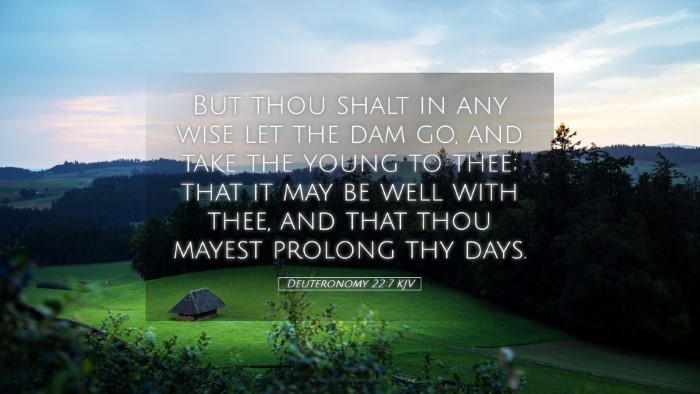Commentary on Deuteronomy 22:7
Bible Verse: "But when you are on the way, and you find a nest with young ones, or eggs, and the mother sitting on the young or on the eggs, you shall not take the mother with the young." (Deuteronomy 22:7, ESV)
Introduction
This verse encapsulates a pivotal principle found throughout the Law of Moses: the importance of compassion, respect for life, and stewardship over creation. In the wider context of Deuteronomy 22, which addresses various laws concerning social justice, responsibility, and ethical behavior, this command focuses on the treatment of animals and the considerations necessary in our interactions with nature.
Authoritative Interpretations
Various esteemed public domain commentaries provide insights into the intent and applications of this verse:
Matthew Henry
Compassion for Creation: Henry emphasizes that God is concerned about all His creatures. The command not to take the mother bird along with her young signifies that God is mindful of the mother’s affections and instincts. This teaching unfolds the broader ethical treatment of animals which reflects a compassionate heart.
Respecting Parental Bonds: Henry notes that this law is indicative of the respect for familial bonds, which exists not only among humans but also in the animal kingdom. The inherent compassion reflected in this verse mirrors God’s love for His creations; thus, adherence to these laws fosters a spirit of respect towards all living things.
Albert Barnes
Symbolism of the Nest: Barnes offers a symbolic interpretation of the nest, suggesting that it represents the home and familial units. By preserving the mother bird, the passage advocates for the protection of family integrity, suggesting the value of nurturing environments, both for animals and within human society.
Social Justice Aspect: Barnes also connects the compassionate treatment of animals to broader themes of social justice within the community. The ethical treatment of creatures reflects moral integrity and establishes standards for humane interactions not just with nature, but with each other.
Adam Clarke
Underlying Principle of Mercy: Clarke elucidates that this command reflects a deeper principle of mercy. He articulates that even in matters pertaining to animals, God desires mercy over sacrifice. The depth of this command underscores God’s intention that mercy should permeate our actions, urging humans to prioritize kindness even in mundane interactions.
Guidance for Daily Life: Clarke asserts that such specific commands may serve practical purposes in daily life by shaping individual character and morality. The practice of preserving the life of the mother bird can extend to shaping human interactions that prioritize value and care for one another, fostering a life defined by ethical considerations.
Theological Implications
This seemingly simple command encapsulates various theological implications that are profound:
- Stewardship and Responsibility: The directive emphasizes stewardship over the creation, compelling believers to recognize their role in caring for the world God has entrusted to them.
- Moral Framework: The verse functions within a moral framework that transcends mere legalism. It invites the faithful to approach divine law with an attitude of love and ethics, influencing behavior towards all creation.
- Reflection of God’s Nature: The command portrays God as a compassionate Creator who cares for even the smallest of creatures, challenging believers to embody this characteristic in their lives.
Practical Applications
For pastors, students, and theologians, this verse invites several practical applications:
- Teaching Creation Care: This command presents an opportunity to teach congregations about the importance of environmental stewardship and the ethical treatment of animals.
- Promoting Compassion in Ethics: The verse can be a springboard for discussions around compassion in personal and community ethics, emphasizing the necessity of kindness and mercy in societal structures.
- Encouraging Reflection on Relationships: It can lead to reflections on the nature of relationships—both human and divine—encouraging individuals to appreciate and safeguard the bonds of love and care that define them.
Conclusion
Deuteronomy 22:7 serves as a reminder of God's care for His creation and invites a reflection on the compassion expected from His followers. This law teaches that our moral responsibilities extend to all creatures, encouraging a life of respect, kindness, and ethical formulation. As we engage with this text, may we not only deepen our understanding but also transform our practices to reflect God’s heart for His creation.


